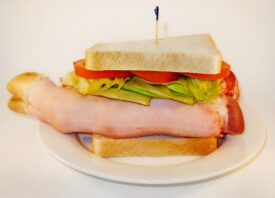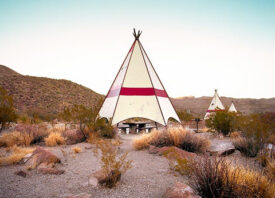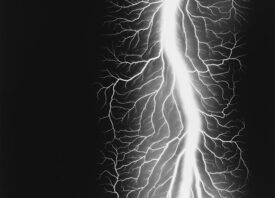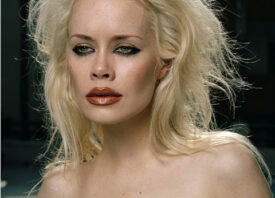Search this site
The Black Hollywood Book Project Is a Photographic Tour de Force


“We’ve been waiting for a book like this.” “It’s taken too long.” “Thank you.” Years in the making, the Black Hollywood Book Project by the photographer Carell Augustus is available now, and the response has been resounding.
On location and in the studio, Augustus collaborated with sixty-five Black celebrities to restage iconic moments in cinematic history, paying homage to performers of the past while also setting the stage for a future where everyone can see themselves represented on the big screen.
Augustus grew up in the 1980s, watching adventure movies featuring primarily white casts, but it wasn’t until much later that he understood the far-reaching implications and consequences of inequality in Hollywood. While working as a photographer in Los Angeles, he remembers publications telling him that magazines with Black stars on the cover didn’t sell as well as those featuring white people.
In the eight years before the #Oscarssowhite movement of 2015, only 8% of Oscar nominees were people of color. It was during this time that Augustus embarked on the Black Hollywood Book Project: if the magazines and casting directors wouldn’t make a change, he would do it himself.
The book brings together some of today’s most recognizable talents, offering a visionary homage to—and examination of—movie magic past and present. It shows us in breathtaking detail what could have been, and, most importantly, it inspires us to reimagine what could be.
For Black History Month this year, when the USC School of Cinematic Arts invited Augustus to speak, a photography student approached him to say he was working on a paper about the Black Hollywood Book Project. “That’s the best response I’ve received so far,” the artist says. We asked him to tell us more.
Black Hollywood: Reimagining Iconic Movie Moments was produced by Ebony’s publishing imprint, Ebony Magazine Publishing. Order your copy here, and follow along on Instagram at @blackhollywoodbookproject.

When did it “click” for you that the world needed a book like the Black Hollywood Book Project and that you were the artist to create it?
“I always wanted to create a work that would make people think. I wanted that work to be centered around black talent, and as an African American photographer, I wanted to do it myself and not wait for someone to hire me to do it or commission me to because that was not going to happen. These kinds of projects are conceived in dreams, and it takes so much to get them going, keep them going, and allow them to flourish. Once I took the first shot, I knew I’d end up with a book and gallery show—something. Starting is half the battle.”

How did you select the celebrities featured in the book, and how did you get in touch with them?
“I used to be the lead photographer for a celebrity gifting company; as a result, I got to interact with some of the celebrities directly. I was able to pitch my idea as a 30-second intro, and that was great because you could tell instantly if they were interested. They knew I was a photographer because I was standing there shooting their photo, so that sort of disarmed them right away.
“If I spoke with them directly, it was a bit easier, but if I had to talk to PR, manager, or agent, it was more difficult. I didn’t have a ‘name’ so it was difficult to get the reps to trust me. I didn’t have a publisher yet, so that was not a good sign to some of them. The few I did get had a great experience and loved their shot; we got to collaborate and make magical photos. Oftentimes, if they gave me their phone numbers or emails or personal assistant, that made contacting and interacting with them easier.”

How did you pair each celebrity with each film and character?
“I matched the celebrity up with a scene that I thought I could mostly see them playing. Corbin Bleu for me definitely has a Tom Cruise quality about him; Simbi Kali and her short twisted hair was the perfect plus to redo the Psycho shower scene. Vanessa Williams, being the first black Miss America, is absolutely beautiful and full of class, strength, and grace; she was the perfect choice for Cleopatra.
“95% of the people I asked to be in the book already had a connection with the character by the time I presented them with an idea. Amber Stevens West told me that she had Audrey Hepburn’s photos in her house, the only photos that were not family. Neil Brown Jr. told me that Die Hard was his favorite movie, so much of the talent really resonated with my ideas. It was remarkable how that aspect came together.
“I also wanted the talent to feel good about the shot and the scene. There were a couple that I had to switch out because if the talent wasn’t comfortable, I had to change it. Jay Ellis was so ready willing and able to American Psycho and offered to go fully nude for the shot, I assured him that we didn’t need him to, but I appreciated his willingness to be authentic to the character.”
Have any of these films been especially influential for your creative practice?
“Back to the Future was a big one for me. It’s the first time I remember a film having a lasting impact on me. When I recreated it, I titled it ‘Black to the Future,’ but we decided not to run it with the font because it was too close to the actual font. Legal said, ‘Let’s get leave it out,’ and I was totally fine with that.

Can you walk us through the process of a typical studio session for the Black Hollywood Book Project? How large was your team?
“My team varied, and occasionally, I’d get the call the day before and had to make it happen. When that was the case, I had to pull everyone who was available together. Five to seven people was ideal: hair, makeup, assistants, props, etc. On average, it took about six hours, start to finish. With enough notice, I tried to have most of the heavy lifting done before the talent arrived. The days leading up to the shoot, I’d sketch out my lighting diagrams and art concepts so that I could hit the ground running on the shoot day.”

What was the most ambitious or challenging session in the book, and how did you pull it off?
“The most challenging was Singin’ In the Rain. We were in one of the top studios in LA, using water without most of the proper requirements, so we had to be extra careful. I bought tons of plastic bags to triple cover the power packs; we had mops and squeegees and took breaks with the water, but we made it happen with no accidents or ruining any of the equipment.”

What session surprised you the most and why?
The Adina Porter as Barbra Streisand was a surprise because they share a very similar profile. I hadn’t really noticed that until she was on set. When I saw her with her wig and earrings (Thanks, Deshon and Dominique), I knew she was the perfect choice.
“Seeing her transform that way was magical. I was just surrounded by so many talented people who shared my vision and really gave 100% of their talents to bring the idea to life. That was so clear when I looked in the viewfinder.”

What is your favorite behind-the-scenes memory from your time working on this book? Any moments or conversations you’ll never forget?
“I did a lot of BTS while shooting. I have a few moments: pretending with Omari Hardwick to be the next buddy cop show and taking photos, screaming with Simbi Kali at the wrap of shooting Psycho, and more. My favorite memory is standing in a line and singing Seasons of Love with Tracie Thoms and others from the shoot, from her movie Rent. She did all the parts of her character, and that was an incredible moment.”

You worked on this book for more than a decade. How did it evolve in that time?
“So much has taken place socially since I started this book: BLM, #Oscarsowhite, Juneteenth finally being recognized, book banning, etc. I had to keep my focus; it was all so distracting and made me question the entire project. I had to forge through. I had to keep my voice and the voice of this art alive.
“At times, it felt like society (and some of our political leaders) were telling me to quit, to stop, to give up. Sometimes, I wanted to, but I realized the work and the message was bigger than me. I had to become unapologetic about it. The biggest evolution was owning it from top to bottom, back to front, and not conforming to anyone.”
In what ways has Hollywood changed since you first began work on the book?
“You definitely see more black leads, black teen shows; there are black creatives in writing rooms; we see black characters with healthy love lives, family lives and relationships; we see all-black casts. These things tend to vacillate in Hollywood, but this last push for diversity seems to be sticking around. I like that.”

(Amber Stevens West in Breakfast at Tiffany’s)
Do you have any advice for emerging artists?
“Perseverance and self-preservation are real, and finding space to walk away and rejuvenate, particularly when you are doing it all alone or you have very little help, is okay. It’s okay to take breaks, rethink, reevaluate, and recharge to make sure, no matter what, that the best version of you is always showing up. It makes all the difference.”
Read these next:
• In 1902, a Black Performer Took the World by Storm. Her Story Resonates Today.
• A Photography Book Honors the Women of the Black Panther Party
• A Timeless Ode to Sisterhood Across the African Diaspora



